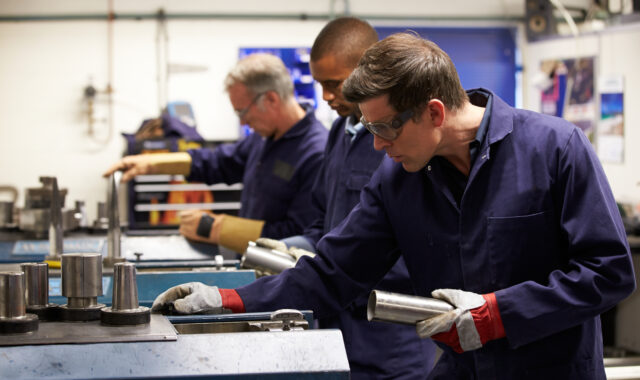Contents:
Qualification Level: Level 6
Age Group: 18+ years
Cost: Earn a wage, employer-funded
Skills Developed: Job-specific practical skills and core industry knowledge
Learning Environment: Workplace and university, unless training online
What is a degree apprenticeship?
A degree apprenticeship is a programme that allows you to earn a bachelor’s degree (level 6) or master’s degree (level 7) while working full-time, with tuition fees covered by your employer or the government.
Typically lasting three to six years, these apprenticeships are designed primarily for 18 and 19-year-old school leavers, though they are also available to mature students seeking a career change. They offer a practical higher education option, providing both industry experience and a recognised university qualification, supported by expert mentorship and high-quality teaching.
If you’re drawn to degree apprenticeships for financial reasons but prefer a more traditional university experience, a sponsored degree may be a better option.
This comprehensive guide will explain how degree apprenticeships work, evaluate their benefits, and guide you through the application process.
This guide is designed specifically for those looking into degree apprenticeships as a post-18 option. For a general guide to apprenticeships, check out our dedicated apprenticeships article.
What degree apprenticeships are there in STEM?
Degree apprenticeships are particularly well-suited to STEM fields because they blend academic learning with hands-on experience, allowing students to apply theoretical knowledge directly to real-world challenges.
Explore the articles below for detailed information on the STEM apprenticeships available within each field:
Structure of STEM degree apprenticeships
As a degree apprentice, you will work full-time for an employer, dedicating 80% of your time to on-the-job learning and at least 20% to off-the-job training at a university. This off-the-job training can be arranged as one day per week at university or in longer blocks, alternating between work and study.
Apprentices must work a minimum of 30 hours per week to be classified as a full-time apprentice. This includes time spent off-the-job at a university. In most sectors, you can expect to work between 9am and 5:30pm, although jobs in healthcare often have shifts in unsocial hours.
How are degree apprenticeships assessed?
Degree apprenticeships are assessed through an End-Point Assessment (EPA), much like the assessment process for other apprenticeships. The EPA follows specific guidelines set by the EPA organisation and is usually conducted by an independent assessor, separate from your university or employer.
This assessment measures the Knowledge, Skills, and Behaviours (KSBs) required by your degree apprenticeship, as defined by industry experts. These typically include at least two of the following methods:
- Practical assessment
- Interview
- Project
- Written and/or multiple choice test
- Presentation or sales pitch

Whether your EPA is part of your degree assessment depends on whether your apprenticeship is integrated or non-integrated.
- In integrated degree apprenticeships, the EPA is built into the programme, meaning you can’t pass the degree without passing the EPA.
- For a non-integrated degree apprenticeship, a degree is combined with additional workplace training to meet the apprenticeship standards. In this case, you will complete an EPA in addition to your university degree assessment.
Based on your performance, you will be awarded a pass, merit, or distinction. This is in addition to the traditional university class grading system for your academic degree. If you fail to pass the EPA, you can resit or retake the assessment, but only to achieve a pass – not to improve your final grade.
A bachelor’s degree will be awarded for level 6 degree apprentices, and a master’s degree for level 7 apprentices.
For further details on the awarding organisation, framework and assessment structure, you can refer to our general apprenticeships article.
How much do degree apprenticeships pay?
One of the biggest draws of a degree apprenticeship is the financial aspect. Unlike traditional university degrees, you will not have to pay tuition fees as they are covered by your employer. However, you will not be eligible for a student loan, leaving you to cover your own living expenses.
To help with this, degree apprenticeships come with a wage. As of April 2024, the National Minimum Wage for apprentices is:
- Under 19: £6.40/hour
- Aged 19 or over and in your first year of apprenticeship: £6.40/hour
- Aged 19 to 20 and have completed your first year: £8.60/hour
- Aged 21+ and have completed your first year: £11.44/hour
These wages help offset the cost of living, making degree apprenticeships an attractive option for those who want to earn while they learn. You can also check out our article on STEM scholarships, grants and bursaries to find out how you may be able to secure additional non-repayable financial support.
How to apply for a degree apprenticeship
The application process for a degree apprenticeship can be confusing because it involves both a university and an employer. Usually, you apply directly to the employer, who will then arrange your training with their partner university. In this section we will explore how to find and secure a degree apprenticeship.

How to find degree apprenticeships
Finding the right degree apprenticeship can be challenging since you need to apply to an employer while ensuring they partner with the university and course you are interested in. Fortunately, there are several resources to assist you in your search:
- Government ‘Find an apprenticeship’ service: England, Scotland, Wales and Northern Ireland): This is an official online tool provided by the UK government, offering a comprehensive database of apprenticeship opportunities. You can search by location, industry, and apprenticeship level.
- UCAS ‘Search apprenticeships’ service: UCAS, known for university applications, also offers a search tool for apprenticeships. This service allows you to explore degree apprenticeship options alongside traditional university courses, making it easier to compare your choices.
- Employer or university websites: Most companies and universities list their apprenticeship programmes online, providing detailed information about the roles and how to apply.
- Job search platforms: Websites like Indeed, LinkedIn jobs, and TotalJobs also list degree apprenticeships and often allow you to set up alerts for new apprenticeship postings.
- Apprenticeship fairs: You can search for local events by googling “apprenticeship fair in [your area].” For example, the Festival of Apprenticeships in London, Birmingham, and Manchester is a popular event where you can meet potential employers, learn about different apprenticeships, and network with professionals.
Our dedicated articles on science, technology, engineering, maths, and medicine apprenticeships can help you tailor your search to specific niches.
Factors to consider when searching for a degree apprenticeship
- Duration: How long is the placement for?
- Entry requirements: Do you need any qualifications or prior experience?
- Integrated or non-integrated: Will you need to take more time after finishing your degree to complete the EPA?
- Qualifications: Which qualification(s) will you get upon completion of the apprenticeship?
- Apprenticeship standards: What will be expected of you? What industry regulations will you need to meet by the end of your apprenticeship?
- Job role: What will you actually be doing, and will you enjoy it?
- Timetable: How will your time be divided between your degree and work? Is your training delivered on day or block release?
- Accreditation: Is the placement recognised by the relevant organisations or committees?
- Reputation: Has this employer had apprentices before? What do people think of the employer and the placement they offer?
- Employment: If the apprenticeship is advertised by a training provider, does the vacancy include a job placement or will you need to find one? If not, will your training provider help you find a suitable job placement?
What are the entry requirements for degree apprenticeships?
Exact requirements vary, but employers generally expect at least 5 GCSE passes, including English and maths, along with some Level 3 qualifications such as A Levels, BTECs, or T Levels.
For specific courses, like medicine or engineering, you may need qualifications in particular subjects in order to provide the necessary base knowledge. Other fields may have more flexible requirements and be open to a broader range of academic backgrounds. Some may also require relevant work experience.
Always verify the specific entry requirements with the apprenticeship provider and partner university.
What is the application process for degree apprenticeships?
Applying for a STEM degree apprenticeship is much like applying for a job. You will typically need to submit a CV and cover letter and may be invited to an interview. Check out our article about applying to STEM career opportunities for a CV template and support with this process.

Opportunities are posted throughout the year, unlike university applications which occur once a year. Application cycles can differ between businesses, with some requiring applications several months in advance and others having shorter timelines. Check regularly and keep a calendar of key deadlines to ensure you don’t miss any.
The application process is competitive and it’s unlikely you will be accepted into the first programme you apply for. To improve your chances, apply to multiple apprenticeships. It is also wise to apply to universities alongside apprenticeships, providing you with a backup plan and keeping your options open. While it is easy to decline a university offer later, securing one after missing the deadline is often much more difficult.
Graduate outcomes degree apprenticeships
The chances of securing full-time employment after a degree apprenticeship are very high. While a job isn’t guaranteed, over 90% of degree apprentices remain in some form of employment, and nearly 5% continue to learn and work. Degree apprentices often experience significant career advancement and can reach higher levels within companies; for example, 30% of senior managers at Rolls-Royce started as apprentices.
Additionally, completing a degree apprenticeship often brings you closer to achieving chartered status or professional registration in your field. This indicates that you have met the required education, training, and work experience to demonstrate professional competency.
Is a degree apprenticeship worth it?
Degree apprenticeships can be an excellent choice, offering substantial financial benefits, practical work experience, and strong employment prospects, with many apprentices securing full-time positions and advancing to senior roles within their companies.
However, they come with challenges such as balancing work and study, limited availability, and varying quality depending on the employer. Additionally, while the skills gained are often transferable across industries, the technical expertise gained may be more specialised, potentially restricting your career options to a specific field.
Overall, if you’re seeking to earn a degree while gaining hands-on experience with no tuition fees, a degree apprenticeship may be the perfect choice for you. Read on to our next article for a detailed comparison between university degrees and degree apprenticeships.

FAQs
When do degree apprenticeships open?
Degree apprenticeships are advertised by employers throughout the year, so there isn’t a set application cycle like there is with traditional university admissions. Despite this flexibility, many degree apprenticeships start in September to align with the academic year, as this is often when students are actively seeking positions.
The degree apprenticeship’s job description will include the application deadline and the expected start date.
Which universities offer degree apprenticeships?
All degree apprenticeships are partnered with a university, providing the academic training component of the programme. Typically, you apply directly to the employer who arranges the training with a partner university. However, in some cases, you can apply through the university, which will then match you with an appropriate employer.
Check out The Scholarship Hub’s list of universities offering degree apprenticeships for specific training providers.
Which companies offer degree apprenticeships?
A wide variety of employers across various industries offer degree apprenticeships. This includes large multinational corporations as well as smaller companies. For detailed information, you can explore our articles that highlight the top employers offering degree apprenticeships in science, technology, engineering, maths, and medicine.
Can you do a degree apprenticeship if you already have a degree?
Yes, you can pursue a degree apprenticeship even if you already hold a degree, provided it is in a different subject area. This is because degree apprenticeships are a government-funded scheme designed to help individuals gain new skills.
However, it’s important to consider whether this is the best option for you. If you already have a degree, you might want to explore graduate-entry programmes or conversion courses. This could help you advance your career more quickly, rather than starting over at the same level as someone who has just finished studying STEM in school.
Can you do an apprenticeship part-time?
Yes, it is possible to do a degree apprenticeship part-time, and these programmes take longer to complete, typically lasting four to six years compared to the three to five years required for full-time apprenticeships. To be classified as full-time, you must work a minimum of 30 hours per week.
Do apprentices get student perks and discounts?
Whether you can get student discounts as an apprentice depends on the organisation and training provider. If you are training at a college or university and have a student email address, you should be able to sign up for student discount websites like UNiDAYS.
The TOTUM Apprentice Card is a discount card specifically for apprentices. From £8.33 per year (for 3 years), it offers discounts on many brands both online and on the high street.
Also, watch out for local schemes, such as London’s Apprentice Oyster photo card, which provides up to 30% off certain journeys.
Apprenticeship vs university: Which is right for me?
Choosing between a degree apprenticeship and a traditional university degree depends on your personal and career goals. Degree apprenticeships offer practical, hands-on experience in a work environment, while university degrees provide a broader academic focus and more flexibility in terms of subject matter. For a detailed comparison, read our dedicated article, Degree apprenticeship vs university: Pros and cons.
How competitive are degree apprenticeships?
Degree apprenticeships can be highly competitive, especially for popular courses. Employers typically look for candidates with strong academic records, relevant skills, and a clear commitment to the field they wish to enter.








Comments